Digs & Discoveries
Return to Sender
By DANIEL WEISS
Thursday, June 10, 2021
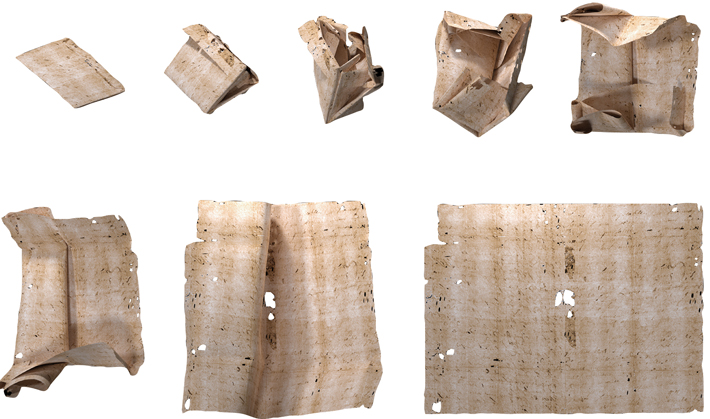
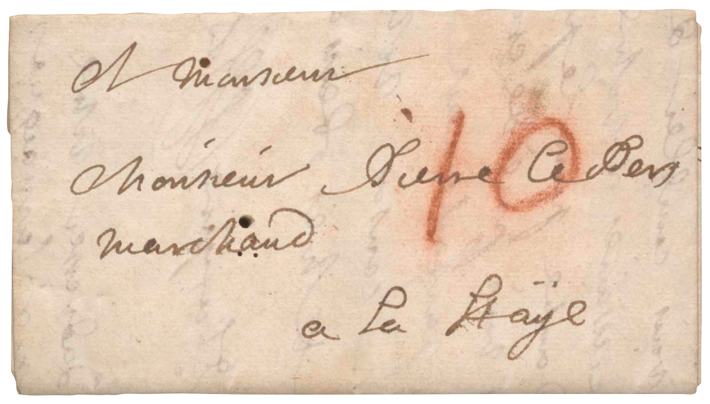
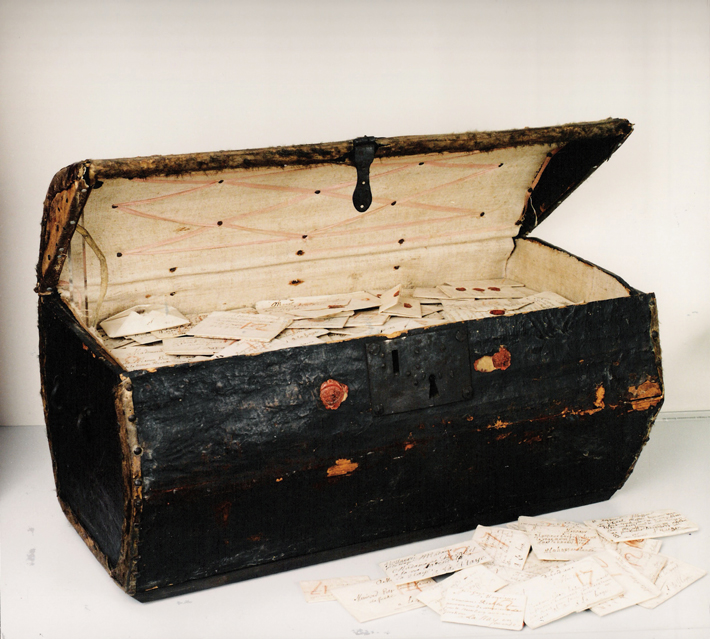 A team of researchers has virtually unfolded and read a letter that has remained unopened since it was mailed more than three centuries ago. Like many letters sent before the introduction of mass-produced envelopes in the early nineteenth century, this missive was intricately folded into a secure packet using a process called letterlocking. All that is visible on its exterior is the name of its intended recipient: Pierre Le Pers, a merchant in The Hague.
A team of researchers has virtually unfolded and read a letter that has remained unopened since it was mailed more than three centuries ago. Like many letters sent before the introduction of mass-produced envelopes in the early nineteenth century, this missive was intricately folded into a secure packet using a process called letterlocking. All that is visible on its exterior is the name of its intended recipient: Pierre Le Pers, a merchant in The Hague.
The researchers scanned the packet using a high-resolution, high-contrast CT scanner designed for dentistry. The device is able to clearly image substances with very different densities, such as low-density paper and high-density, iron-containing ink. The team developed an algorithm that, along with a 3-D image produced from the scanner’s data, allowed them to determine how the paper was folded. They then “unfolded” it and flattened it into a 2-D image, enabling them to read the original letter without opening and potentially damaging it.
The letter is one of a trunkful of undelivered missives held by two postmasters in The Hague. It was dated July 31, 1697, and written by Le Pers’ cousin, Jacques Sennacques, requesting a certified copy of the death notice of a man named Daniel Le Pers. Sennacques likely sought proof that Daniel Le Pers died before French inheritance laws had changed several years earlier. “Sennacques writes, ‘You didn’t answer my last letter!’” says Daniel Starza Smith, a lecturer in early modern English literature at King’s College London. “Obviously, this one’s gone unanswered, too. The poor guy probably ended up paying more inheritance tax than he needed to.”
To see an animation of the unfolding of a seventeenth-century letter, click below. (The animation is courtesy the Unlocking History Research Group archive.)
Mirror, Mirror
By LING XIN
Thursday, June 10, 2021
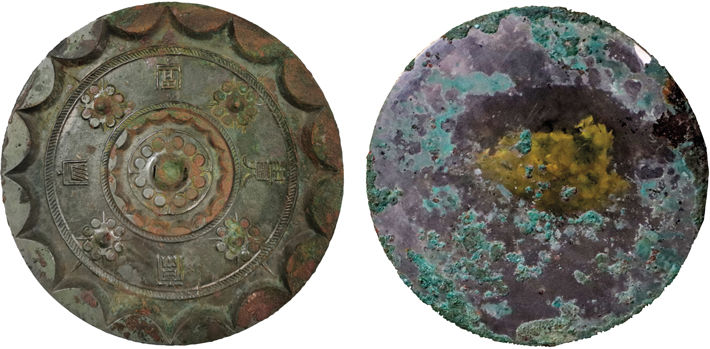
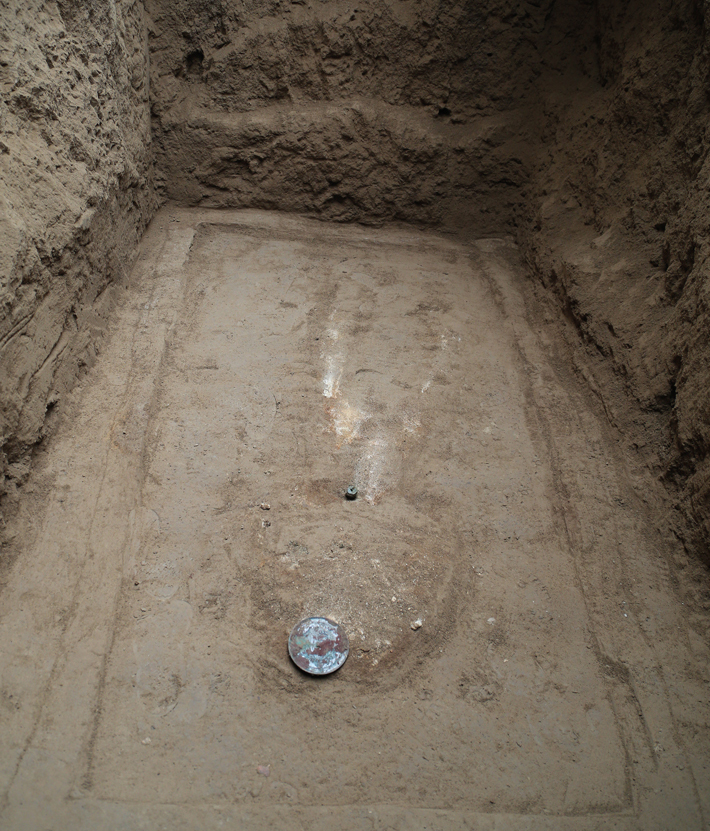 An array of 2,000-year-old bronze mirrors unearthed in a cemetery in the suburbs of Xi’an, China, has shed new light on funeral customs and daily life during the Western Han Dynasty (206 B.C.–A.D. 9). Among the 87 circular mirrors, which vary in size from three to eight inches in diameter, several can still reflect images. “They clearly show petals of flowers, or the brand name on your drink,” says lead researcher Yingpei Zhu from Shaanxi Academy of Archaeology. On the back of each mirror is a central knob surrounded by decorative images such as dragons and stars. According to Zhu, these mirrors belonged to ordinary citizens. In most cases, the mirror was placed near the head or chest of the tomb owner. In one well-preserved tomb, four mirrors were placed in a stack, indicating the owner might have been wealthy—or just a devoted mirror aficionado.
An array of 2,000-year-old bronze mirrors unearthed in a cemetery in the suburbs of Xi’an, China, has shed new light on funeral customs and daily life during the Western Han Dynasty (206 B.C.–A.D. 9). Among the 87 circular mirrors, which vary in size from three to eight inches in diameter, several can still reflect images. “They clearly show petals of flowers, or the brand name on your drink,” says lead researcher Yingpei Zhu from Shaanxi Academy of Archaeology. On the back of each mirror is a central knob surrounded by decorative images such as dragons and stars. According to Zhu, these mirrors belonged to ordinary citizens. In most cases, the mirror was placed near the head or chest of the tomb owner. In one well-preserved tomb, four mirrors were placed in a stack, indicating the owner might have been wealthy—or just a devoted mirror aficionado.
A Challenging World
By JARRETT A. LOBELL
Thursday, June 10, 2021
 There are many extremely challenging places to dig. In Luxor, Egypt, site of a newly discovered 18th Dynasty city (See “Lost Egyptian City”), temperatures often rise above 100°F. At the Yana Rhinoceros Horn site in remote northeastern Siberia, where scientists have found 31,000-year-old baby teeth belonging to a previously unknown human population, it can be as cold as −46°F. Some archaeologists regularly dive to the depths of the ocean. In the field, they can face venomous scorpions and active volcanoes. And there are the dangers of the modern world—the “Big Dig” was conducted in downtown Boston as a new highway was built overhead, and the recent coup in Myanmar has put archaeological work on hold.
There are many extremely challenging places to dig. In Luxor, Egypt, site of a newly discovered 18th Dynasty city (See “Lost Egyptian City”), temperatures often rise above 100°F. At the Yana Rhinoceros Horn site in remote northeastern Siberia, where scientists have found 31,000-year-old baby teeth belonging to a previously unknown human population, it can be as cold as −46°F. Some archaeologists regularly dive to the depths of the ocean. In the field, they can face venomous scorpions and active volcanoes. And there are the dangers of the modern world—the “Big Dig” was conducted in downtown Boston as a new highway was built overhead, and the recent coup in Myanmar has put archaeological work on hold.
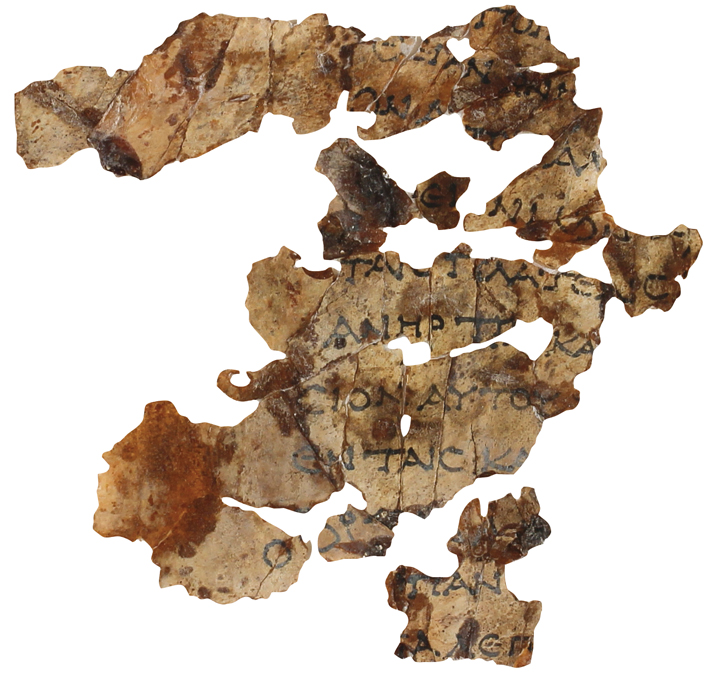 But there are few places where more challenges collide than the Judean Desert in Israel and the Israeli-occupied West Bank, home of the Dead Sea Scrolls. The scrolls, the first of which were found in 1947 by a Bedouin shepherd in the Qumran Caves at the north end of the Dead Sea, contain the earliest known copies of biblical books, along with other Jewish religious writings, personal letters, and administrative documents dating from the mid-third century B.C. to the early second century A.D. For the past five years, Israel Antiquities Authority (IAA) archaeologists have investigated 580 known caves in the cliffs of the Judean Desert, where the logistical difficulties are unique, explains archaeologist and deputy director of the IAA Theft Prevention Unit, Eitan Klein. “Most of the caves can only be accessed using ropes due to their location in the middle of very steep cliffs,” he says. “The area is very remote and there are communication problems that can cause safety issues.” Compounding these obstacles is the fact that some of the caves are in the occupied territories. According to international law, removing artifacts from these sites is illegal, which raises political and ethical concerns. Looters also pose an ever-present threat.
But there are few places where more challenges collide than the Judean Desert in Israel and the Israeli-occupied West Bank, home of the Dead Sea Scrolls. The scrolls, the first of which were found in 1947 by a Bedouin shepherd in the Qumran Caves at the north end of the Dead Sea, contain the earliest known copies of biblical books, along with other Jewish religious writings, personal letters, and administrative documents dating from the mid-third century B.C. to the early second century A.D. For the past five years, Israel Antiquities Authority (IAA) archaeologists have investigated 580 known caves in the cliffs of the Judean Desert, where the logistical difficulties are unique, explains archaeologist and deputy director of the IAA Theft Prevention Unit, Eitan Klein. “Most of the caves can only be accessed using ropes due to their location in the middle of very steep cliffs,” he says. “The area is very remote and there are communication problems that can cause safety issues.” Compounding these obstacles is the fact that some of the caves are in the occupied territories. According to international law, removing artifacts from these sites is illegal, which raises political and ethical concerns. Looters also pose an ever-present threat.
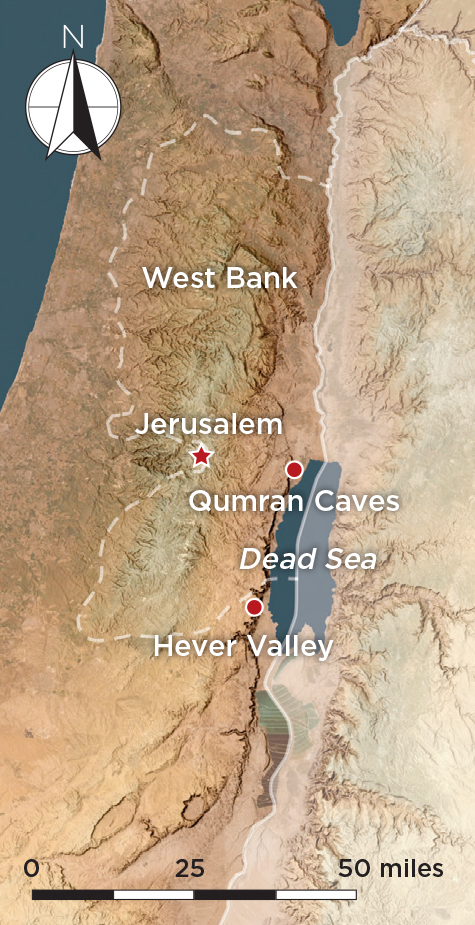 Located 260 feet below the top of a steep cliff, Cave 8 is in one of the Hever Valley’s most remote locations and has proved especially difficult for archaeologists to explore. The cave was first excavated in the 1950s and 1960s, when archaeologists discovered the skeletons of 40 adults and children, the remains of rebels who had fled to the area at the end of the Bar Kokhba Revolt, a Jewish rebellion against Roman rule from A.D. 132 to 135. During the recent campaign, the team unearthed coins bearing Jewish symbols, as well as spearheads and arrowheads, textiles, sandals, and lice combs belonging to the refugees in the cave. They also recovered 70 small pieces of parchment and a few scraps of papyrus, 30 of which of have writing on them, representing the first fragments of any biblical text to be uncovered in 60 years. “They took their most important belongings with them, including the scroll,” says Klein, “and they probably read those prophecies in the last hours of their lives to encourage their souls.”
Located 260 feet below the top of a steep cliff, Cave 8 is in one of the Hever Valley’s most remote locations and has proved especially difficult for archaeologists to explore. The cave was first excavated in the 1950s and 1960s, when archaeologists discovered the skeletons of 40 adults and children, the remains of rebels who had fled to the area at the end of the Bar Kokhba Revolt, a Jewish rebellion against Roman rule from A.D. 132 to 135. During the recent campaign, the team unearthed coins bearing Jewish symbols, as well as spearheads and arrowheads, textiles, sandals, and lice combs belonging to the refugees in the cave. They also recovered 70 small pieces of parchment and a few scraps of papyrus, 30 of which of have writing on them, representing the first fragments of any biblical text to be uncovered in 60 years. “They took their most important belongings with them, including the scroll,” says Klein, “and they probably read those prophecies in the last hours of their lives to encourage their souls.”
Except for the name of God, which appears in Paleo-Hebrew, the late first-century B.C. text is written in Greek and consists of missing fragments from the Greek Minor Prophets Scroll, which was found in Cave 8 in the 1950s. Some fragments are blank, while others contain 11 lines from the Book of Zechariah as well as lines from the Book of Nahum. “The fact that the scroll is in Greek tells us that at least some of the rebels were fluent and comfortable using Greek for holy texts,” says Oren Ableman, curator-researcher in the Dead Sea Scrolls unit of the IAA. “It was a real privilege to be the first person in two thousand years to read some parts of this scroll and a joy to find surprising text in the fragments.”
And therein lies another challenge. The Dead Sea Scrolls were written in multiple different languages over hundreds of years and, in the case of the biblical texts, copied by multiple scribes many times over. Sometimes more than one scribe worked on the same scroll. And sometimes mistakes were made by scribes copying the texts, creating even more difficulties. “For example, it was baffling to find the word ‘streets’ where all other manuscripts have the word ‘gates,’” Ableman says. “At first, I thought I might have made a mistake. However, eventually I concluded that the mistake wasn’t mine, but rather was made by a scribe in antiquity.”
The Spider's on the Wall
By BENJAMIN LEONARD
Thursday, June 10, 2021
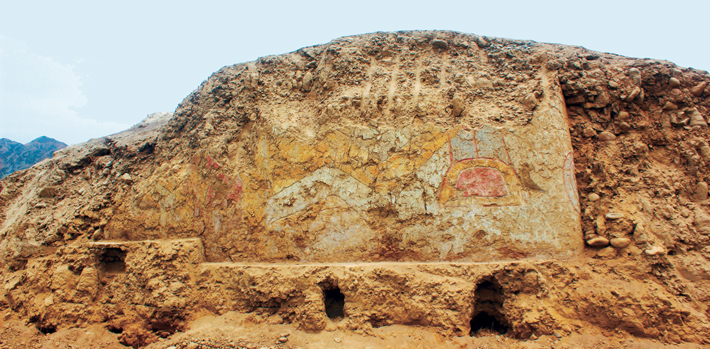 Farmers in Peru’s Virú Province accidentally unearthed a temple complex dating to between 1000 and 200 B.C. in an earthen mound. Although the farmers’ heavy machinery destroyed much of the site, a vibrant, multicolored mural was preserved on a wall of one of the complex’s adobe buildings. The compound was built by people of the Cupisnique culture who lived along Peru’s northern coast for some 2,000 years. At the mural’s center is a figure holding a ceremonial knife in one of its many limbs. The figure, which also appears on Cupisnique stone vessels, has been interpreted as a spiderlike god. According to archaeologist Régulo Franco Jordán of the Wiese Foundation, this is the first known depiction of the supernatural being on a Cupisnique mural. The Cupisnique people relied on seasonal rains for their survival, and Jordán suggests that the temple’s location in a valley near the right bank of the Virú River connects the site to the worship of water deities, likely including the mysterious spider figure.
Farmers in Peru’s Virú Province accidentally unearthed a temple complex dating to between 1000 and 200 B.C. in an earthen mound. Although the farmers’ heavy machinery destroyed much of the site, a vibrant, multicolored mural was preserved on a wall of one of the complex’s adobe buildings. The compound was built by people of the Cupisnique culture who lived along Peru’s northern coast for some 2,000 years. At the mural’s center is a figure holding a ceremonial knife in one of its many limbs. The figure, which also appears on Cupisnique stone vessels, has been interpreted as a spiderlike god. According to archaeologist Régulo Franco Jordán of the Wiese Foundation, this is the first known depiction of the supernatural being on a Cupisnique mural. The Cupisnique people relied on seasonal rains for their survival, and Jordán suggests that the temple’s location in a valley near the right bank of the Virú River connects the site to the worship of water deities, likely including the mysterious spider figure.
Advertisement
Advertisement
IN THIS ISSUE
Digs & Discoveries
A Challenging World
The Spider's on the Wall
Mirror, Mirror
Return to Sender
The Copper Standard
Red Carpet Treatment
Buddhist Retreat
Tubman's Training Ground
Anchors Aweigh
In the Anatolian Arena
Lost Egyptian City
Laws of the Land
Bathing at the Bar
Off the Grid
Around the World
Ancient Australian multi-tools, Africa’s oldest house, Neanderthal hygiene, and Viking warrior bedding
Artifact
All wonders great and small
Advertisement

Recent Issues
-
 May/June 2024
May/June 2024
-
 March/April 2024
March/April 2024
-
 January/February 2024
January/February 2024
-
 November/December 2023
November/December 2023
-
 September/October 2023
September/October 2023
-
 July/August 2023
July/August 2023
-
 May/June 2023
May/June 2023
-
 March/April 2023
March/April 2023
-
 January/February 2023
January/February 2023
-
 November/December 2022
November/December 2022
-
 September/October 2022
September/October 2022
-
 July/August 2022
July/August 2022
-
 May/June 2022
May/June 2022
-
 March/April 2022
March/April 2022
-
 January/February 2022
January/February 2022
-
 November/December 2021
November/December 2021
-
 September/October 2021
September/October 2021
-
 July/August 2021
July/August 2021
-
 May/June 2021
May/June 2021
-
 March/April 2021
March/April 2021
-
 January/February 2021
January/February 2021
-
 November/December 2020
November/December 2020
-
 September/October 2020
September/October 2020
-
 July/August 2020
July/August 2020
-
 May/June 2020
May/June 2020
-
 March/April 2020
March/April 2020
-
 January/February 2020
January/February 2020
-
 November/December 2019
November/December 2019
-
 September/October 2019
September/October 2019
-
 July/August 2019
July/August 2019
-
 May/June 2019
May/June 2019
-
 March/April 2019
March/April 2019
-
 January/February 2019
January/February 2019
-
 November/December 2018
November/December 2018
-
 September/October 2018
September/October 2018
-
 July/August 2018
July/August 2018
-
 May/June 2018
May/June 2018
-
 March/April 2018
March/April 2018
-
 January/February 2018
January/February 2018
-
 November/December 2017
November/December 2017
-
 September/October 2017
September/October 2017
-
 July/August 2017
July/August 2017
-
 May/June 2017
May/June 2017
-
 March/April 2017
March/April 2017
-
 January/February 2017
January/February 2017
-
 November/December 2016
November/December 2016
-
 September/October 2016
September/October 2016
-
 July/August 2016
July/August 2016
-
 May/June 2016
May/June 2016
-
 March/April 2016
March/April 2016
-
 January/February 2016
January/February 2016
-
 November/December 2015
November/December 2015
-
 September/October 2015
September/October 2015
-
 July/August 2015
July/August 2015
-
 May/June 2015
May/June 2015
-
 March/April 2015
March/April 2015
-
 January/February 2015
January/February 2015
-
 November/December 2014
November/December 2014
-
 September/October 2014
September/October 2014
-
 July/August 2014
July/August 2014
-
 May/June 2014
May/June 2014
-
 March/April 2014
March/April 2014
-
 January/February 2014
January/February 2014
-
 November/December 2013
November/December 2013
-
 September/October 2013
September/October 2013
-
 July/August 2013
July/August 2013
-
 May/June 2013
May/June 2013
-
 March/April 2013
March/April 2013
-
 January/February 2013
January/February 2013
-
 November/December 2012
November/December 2012
-
 September/October 2012
September/October 2012
-
 July/August 2012
July/August 2012
-
 May/June 2012
May/June 2012
-
 March/April 2012
March/April 2012
-
 January/February 2012
January/February 2012
-
 November/December 2011
November/December 2011
-
 September/October 2011
September/October 2011
-
 July/August 2011
July/August 2011
-
 May/June 2011
May/June 2011
-
 March/April 2011
March/April 2011
-
 January/February 2011
January/February 2011
Advertisement






